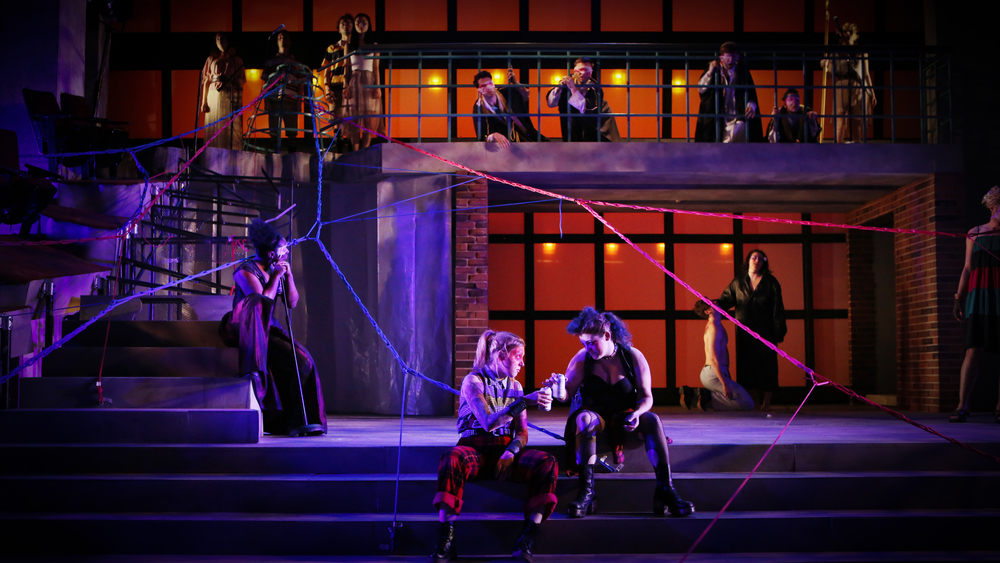
Lulu Fairclough-Stewart ’19 (Odysseus) and Emily Cross ’19 (Agamemnon), center. Photo: Sue Kessler
In Hecuba: Bloodshed, Budweiser, and Raconteurs
By: Gabe Cohn ’16
We tell ourselves stories in order to live. I thought of those words from the opening of Joan Didion’s “White Album” as I experienced Irish playwright Marina Carr’s new version of Eurpides’s Hecuba. Carr’s radical shift of perspective—which aligns us with the Trojans and paints them as victims of a Greek slaughter—calls into question the narrative depicted in the Euripides play, where the Greeks have traditionally been painted as heroic.
Carr’s telling opens with a ripped and vulnerable Hecuba, surrounded by the “limbs, torsos, heads, and corpses of [her] sons.” In one of director Ian Belton’s most radical directorial choices, the Trojan queen (along with several other characters) is depicted by two actors simultaneously—one retrospectively narrating and one physically in the moment (for Hecuba, A’ntonia Benson ’18 and Annabelle Vaës ’19, respectively). They trade off language tit-for-tat, sometimes speaking over each other and sometimes completing each other’s thoughts. Vaës becomes the bloody one, with Benson as her scarred and hardened raconteur. Together, they tell us a new, fresh, and thrilling story, one that history has thus far ignored. The Greeks, Carr seems to argue, have not only told themselves a story in order to live—they have told themselves a story in order to live with themselves.
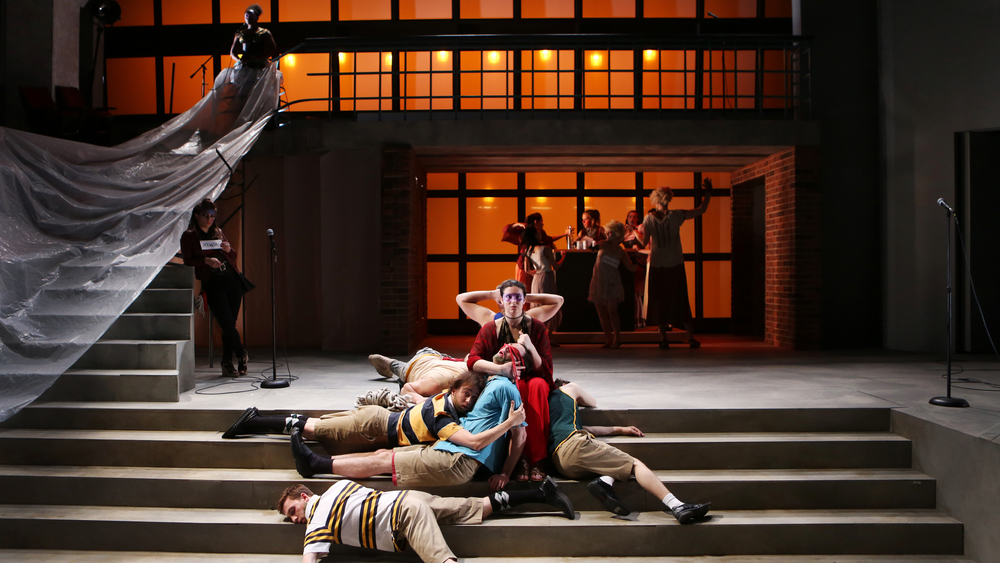
Annabelle Vaës ’19 (Hecuba) holds the head of Woodrow Proctor ’16 (King Priam) while surrounded by her fallen children. Photo: Sue Kessler
If this makes the play sound like an academic exercise, do not fear. In this American premiere production (following a world premiere last year at the RSC), Belton offers up a brand of sensory bombardment that’s more Rocky Horror than Oresteia. Budweiser sprays the stage as frequently as blood does, and the “narrator” sides of characters are often speaking into one of two microphones onstage. They narrate memoirs of their own, desperately speaking their stories into the mics with the apparent hopes that, by being amplified, their stories might be heard by enough ears to be remembered—or better yet, recorded. Carr’s script, punctuated by “He said,” “She said,” and “I said,” has the actors narrating their own actions, as if they are enacting their own war stories around a campfire in Hades. Belton takes the concept and heightens, heightens, heightens.
Hecuba begins at an end. With the play’s action chronologically set in between Homer’s Iliad and The Odyssey, Hecuba picks up after Troy has already fallen, and its main action revolves around the aftermath of Troy’s destruction. Agamemnon (Jack Mulhern ’16 and Emily Cross ’19), having killed King Priam (Woodrow Proctor ’16), searches for Polydorus (Mark Thurner ’17 and Philip Merrick ’19), son of Priam and Hecuba. Along the way, he bonds and clashes with a riotously psychotic Odysseus (Will Clark ’16 and Lulu Fairclough-Stewart ’19), who at one point receives orders from the ghost of the slain Achilles demanding the sacrifice of Hecuba’s surviving daughter, Polyxena (Lucy Consagra ’18 and Wanjun Chen ’19). In all the chaos, this sacrifice becomes the driver of the plot—we gravitate towards it, possibly because Polyxena may be the only truly “innocent” character in the play.
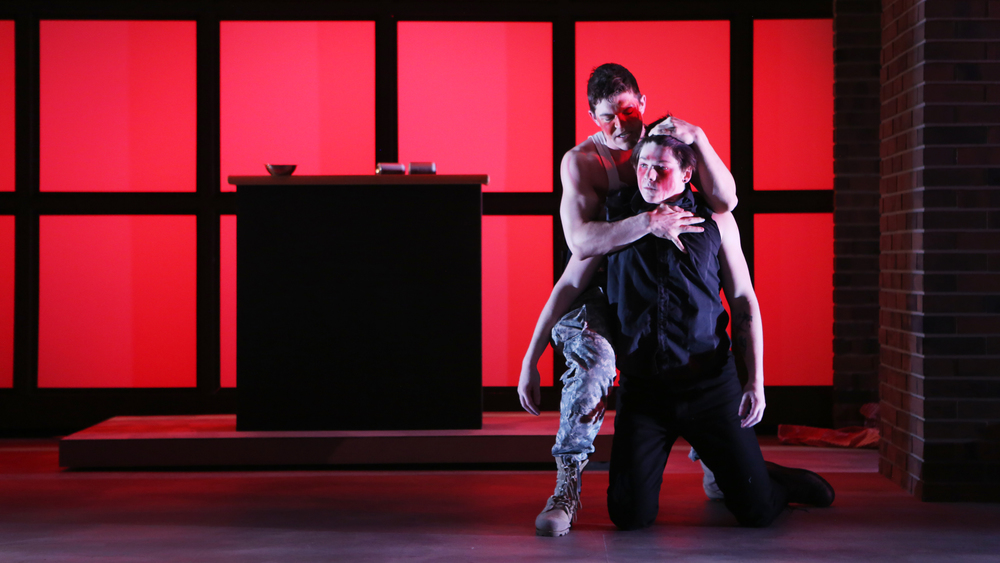
Will Clark ’16 (Odysseus) and Jack Mulhern ’16 (Agamemnon). Photo: Sue Kessler
With Polyxena’s sacrifice, the production’s underlying (but very visible) political themes clearly comes through. At one point, Polyxena cries: “I’m not dying, am I? I’m far too young.” Later, during the sacrifice, we hear her say: “Of all things I’m embarrassed. It’s embarrassing to die like this in front of everyone.” The words hit uncomfortably close to home—we, a 2016 audience conditioned by sudden, unexpected violence and battered by headlines of bombs in train stations, feel closer to the violence of ancient Greece than ever before. “If it’s human sacrifice you want, isn’t one as good as another?” Hecuba pleads moments before Polyxena is killed. “No,” Odysseus responds, “Agamemnon’s command. I don’t know his thinking, I just obey.”
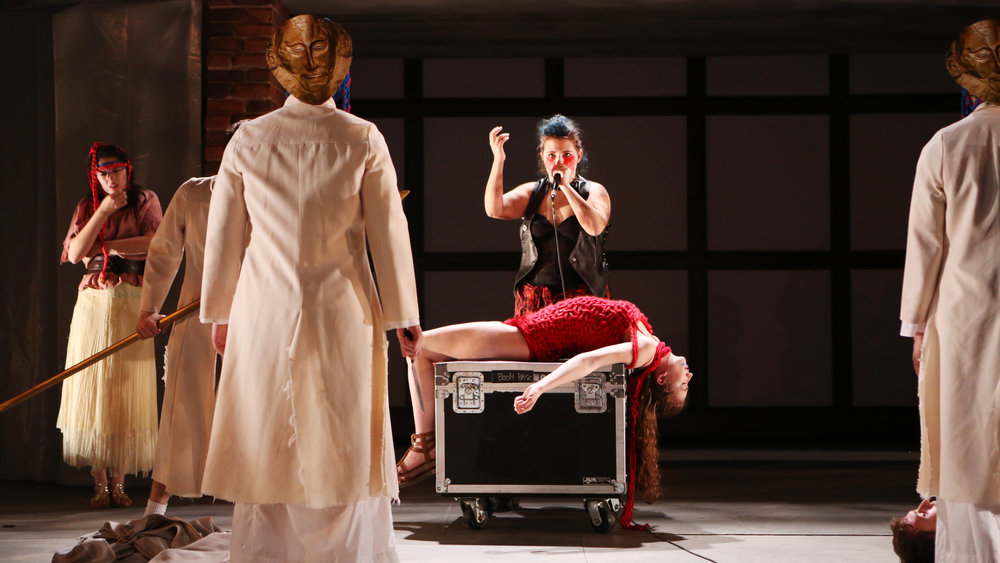
Emily Cross ’19 (Agamemnon) and Lucy Consagra ’18 (Polyxena) during Polyxena’s sacrifice. Photo: Sue Kessler
Set designer Garett E. Wilson drives the timeliness of the production home. With actual seats and carpeting from the JKB, a replica of the railing around the seats, and a backdrop based on the windows of the theater’s lobby, the set makes the stage look like a gigantic mirror, reflecting back to us an alternate reality in which the JKB has taken the same batters and blows that Carr’s Troy has. It is a chilling way to stage the play.
Erik Sanko’s eclectic yet subtle sound compositions also add to the atmosphere of the play. Though the production hasn’t publicized it much, Sanko is quietly a “big deal”—he co-artistic directs “Phantom Limb,” a theater company based out of New York, with his wife, Jessica Grindstaff; he releases music as both a solo artist and with his band, Skeleton Key; and he’s played bass for both John Cale and Yoko Ono, among others. Apparently, Ian Belton met Sanko at a party a few weeks before rehearsals for Hecuba began, and immediately asked him to collaborate. Sanko’s soundscape, a mixture of contemporary music, jazz, piano, and electronic sounds, adds to the “throw-everything-against-the-wall-and-see-what-sticks” mentality that seems to drive this production, though it serves principally to create an atmosphere, rather than take center stage itself. There are often so many things happening on stage that Sanko’s sounds blend in with the chaos, underscoring the anarchy of it all.
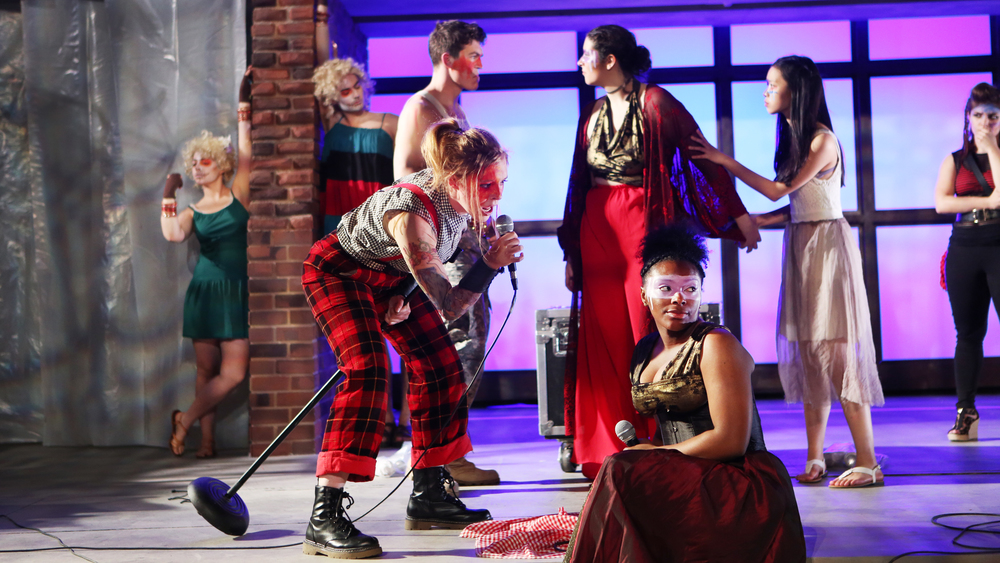
Lulu Fairclough-Stewart ’19 (Odysseus) and A’ntonia Benson ’18 (Hecuba). Photo: Sue Kessler
For all its purposeful disorder, though, Belton’s work, coupled with Carr’s emphasis on other perspectives, asks a very clear (and uncomfortable) question of its Western audience: Who are the victims in 2016? Would there even be a story here today? Or would Odysseus, Agamemnon, and the rest of their Greek cohorts be reduced to a singular radio-controlled drone, too high up to make out the Trojan’s suffering and immediately cruising away—already en route to its next target by the time its missile strikes.
***
Gabe Cohn is a senior English major and Editor-in-Chief/Founder of the Living Newsletter. He has recently contributed to Culturebot, and in May will begin an editorial internship with American Theatre magazine.
Production Photos
Reflections from the Cast + Crew
CLICK HERE to read an extended reflection from Assistant Stage Manager Allyson Schult ’17
Kendall Gross ’16 (Stage Manager): Even though the actors didn’t have the Carr script in-hand until less than a month before opening, we really hit the ground running with this process…On all fronts. So much effort, time, and creativity went into the final product, starting from day one. Hecuba was a massive collaborative effort. I love stage managing because I get to see and explore all the elements of a show in their various states of completion. Knowing how hard everyone worked on Hecuba, and having been involved in the epic adventure that was the days leading up to April 8th, made opening night all the more exciting and satisfying. It wouldn’t surprise me if everyone involved spent the next few days in hibernation. I know that’s my plan!
Mark Thurner ’17 (Polydorous): Through Ian’s passionate guidance we established a rich, diverse world and a group of collaborators who deeply love and listen to each other. I believe our Hecuba process represented the best of what a theater process can accomplish and the extent to which a company can feel open and loving toward one another. I have learned an extraordinary amount from the process, and will remember it for the rest of my life.
Lucy Consagra ’18 (Polyxena): What really made Hecuba for me was the group of people I got to share the stage with. That cast became such a close knit net for me to fall back on whenever I needed to. There was such a incredible level of trust and respect and admiration the eighteen of us had for each other and despite how crazily hard we were worked each day, it was worth it because of the company we created.
Graham Cook ’19 (Soldier/Labdacus/Priest): My experience with the show was an overall positive one. Some days the cast would think that we’d never be ready to open the show, but I think that was an intentional choice by Ian, and a brilliant one at that. I have been in so many shows that get stale as we run the show over and over again, going through the motions, but with Hecuba, every night I felt as if we learned something new about what worked, what didn’t, and what we had to change. Ian would let us fix our own problems. nstead of asking what went wrong, something would happen on stage and we’d have to fix it creating really powerful moments that wouldn’t have happened otherwise.
Philip Merrick ’19 (Polymestor/Neoptolemus/Polydorus): This has been a pretty crazy experience from start to finish because both the play and the rehearsal process were unconventional. We didn’t even touch the script until halfway through the rehearsal process. I was challenged but ultimately I learned a lot and made some really strong bonds with my fellow cast members.
Molly Burdick ’17 (Cassandra): I couldn’t imagine a better team to go through this process with. It was hard–really hard–at times, and we often felt as though we were walking blindly through a corn maze; we didn’t even see the script for the first two months. But we always checked in with each other and made sure we all found the fun in the wild craziness.
Production Credits
Written by: Marina Carr
Director: Ian Belton
Assistant Directors: Rachel Karp ’18 and Lily Kamp ’18
Stage Manager: Kendall Gross ’16
Set Designer: Garett E. Wilson
Lighting Designer: Jared Klein
Sound Designer: Erik Sanko
Costume Coordinator: Patty Pawliczak
Hair and Makeup Designer: Alyssa Hagerbrant ’16
Cast: A’ntonia Benson ’18 (Hecuba), Annabelle Vaës ’19 (Hecuba), Emily Cross ’19 (Agamemnon), Jack Mulhern ’16 (Agamemnon), Will Clark ’16 (Odysseus), Lulu Fairclough-Stewart ’19 (Odysseus), Karen Hafter ’19 (Andromache/Polymestor), Zoe Lesser ’19 (Andromache), Wanjun Chen ’19 (Polyxena), Lucy Consagra ’18 (Polyxena), Molly Burdick ’17 (Cassandra), Ramsey Daniels ’16 (Cassandra), Woodrow Proctor ’16 (Priam/Polymestor/Achilles’ General), Ted Randell ’19 (Polymestor/Priest/Hector), Philip Merrick ’19 (Polymestor/Neoptolemus/Polydorus), Miranda Park ’17 (Xenia/Polyxena), Graham Cook ’19 (Soldier/Labdacus/Priest), Mark Thurner ’17 (Polydorus/Dead Child/Polyxena).
Crew: Omi Furst ’18 (Asst. Costume Coordinator), Kate Greenberg ’19 (Asst. Stage Manager/Dead Children Chorus), Max Helburn ’18 (Asst. Lighting Designer), Julia Kelliher ’18 (Asst. Costume Coordinator), Lean Mirani ’18 (Asst. Costume Coordinator), Allyson Schult ’17 (Asst. Stage Manager), Nick Graver ’16 (Dramaturge), Francesca Parker ’17 (Dramaturge).
Related Articles
Rebel Director: Ian Belton’s Nomadic Journey
Behind-the-Scenes: Researching “Hecuba”
Q&A With “Hecuba” Makeup/Hair Designer Alyssa Hagerbrant ’16
VIDEO: Interview with “Hecuba” Director Ian Belton
VIDEO: JKB Life, Hecuba Dress Rehearsal






























